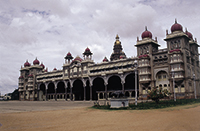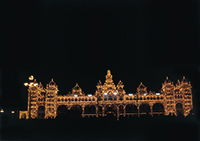About Mysore Information
About Mysore, the city of palaces and parks is the ‘cultural capital’ of Karnataka. The historical town has legendary origins and its name is said to be derived from the word “Mahishasurana Oor”, which means the town of mahishasura. According to a mythological legend, Mahishasura, the demon king, once lived here and was killed by Goddess Chamundeshwari. The Ganga kings ruled here till 10th century and were succeeded by the Cholas, Hoysalas the Vijayanagar Kings. Mysore became the glorious capital of the Wodeyar’s feudatories of the Vijayanagar Empire, who declared independence in 16th century with the decline of Vijayanagar Empire. The Wodeyar rule was disrupted for some time, when Hyder Ali took over the reigns of Mysore in 1765. His son Tipu Sultan, developed the kingdom rapidly, but was defeated by the British in 1799 and Mysore was given back to the Wodeyar’s.
Mysore Palace
This magnificent three storeyed palace in the heart of the town was built between 1897 – 1912 on the foundation of an old palace which was partially destroyed in a fire in 1897. The palace has splendid square towers at cardinal points, crowned with domes. The main attractions are ‘Durbar Hall’ with its ornate ceiling and sculpted pillars and the Kalyanamandapam (Marriage Pavilion), noted for its chandeliers, cast iron pillars, Belgian stained glass arranged in peacock designs in the domed ceilings and glazed tiled flooring. The palace is also known for its rich collection of priceless articles like, a golden howdah (elephant seat), fine paintings and a 200kg gold throne encrusted with precious stones. About 97000 electric bulbs light up the palace in the evenings on Sunday, Public Holidays and during the Mysore Dassara celebrations.
Sri Jayachamarajendra Art Gallery
The art gallery is housed in the Jaganmohan Palace, one of the most beautiful buildings of Mysore. A museum established here in 1915, has a fine collection of ceramics, sandalwood, ivory, stone, antique furniture and ancient musical instruments. It also treasures valuable art collection like traditional Mysore gold leaf paintings and paintings of renowned artists like Travancore ruler, Raja Ravi Varma and the Russian painter Svetoslav Roerich etc.
Rail Museum
It exhibits locomotives and coaches of the erstwhile royal family of Mysore. There are also paintings and photographs describing the story of the railways.
Folklore Museum
The museum at Jayalakshmi Vilas mansion has a rich collection of over 6500 folklore articles and is perhaps the biggest of its kind in Asia. Mysore Zoo or Sri Jayachamrajendra Zoological Gardens. It was set up in 1892, during the rule of Chamrajendra Wodeyar.
St. Philomena’s Cathedral
The imposing twin towered Gothic structure with beautiful stained glass windows.
The Jaganmohan Palace
This is a converted art gallery which houses paintings that date back to the late 19th century. Paintings of Raja Ravi Verma of Travancore and the Russian painter, Svetoslav Roerich are on display. Paintings in the traditional Mysore Golden leaf style can also be seen here.
Chamundi Hill
Perched atop hill is a 12th century temple of Chamundeshwari. About 13km from Mysore by road, there is also a 1000 step walking track for all those young at heart to try. The gigantic 4.8m tall monolith of Nandi, the sacred vehicle of Lord Shiva is marvel to watch. Also close to the temple, stands a gigantic statue of the demon.
The Mysore Zoo
One of the country's best zoo, this is famous for rare animals bred in captivity, and is housed in lush green surroundings.
Brindavan Gardens
9km north-west of Mysore is the famous KRS dam. Built by the famous engineer, Sir.M. Vishvesvariah, this was one of the first multipurpose dam built in India. Adjacent to the dam is the beautiful Brindavan Garden. With lighting and musical fountains, this place transforms itself into a fairyland in the evenings.
Festivals
Dussehra
The pride of Mysore's festivals is Duessehra. It is a celebration that last for ten days. The rulers of Mysore continued the tradition. The Maharaja of Mysore used to hold a durbar for 9 days on the 10th day, went in a procession on a caparisoned elephant. With the ending of the royal rule, a picture of Bhuvaneshwari, the patron goddess of Karnataka, is taken out in procession.
Yugadi
The Kannadiga New Year day of Yugadi that falls on the second half of March or early April is celebrated with devotion and delight.
 |
 |
